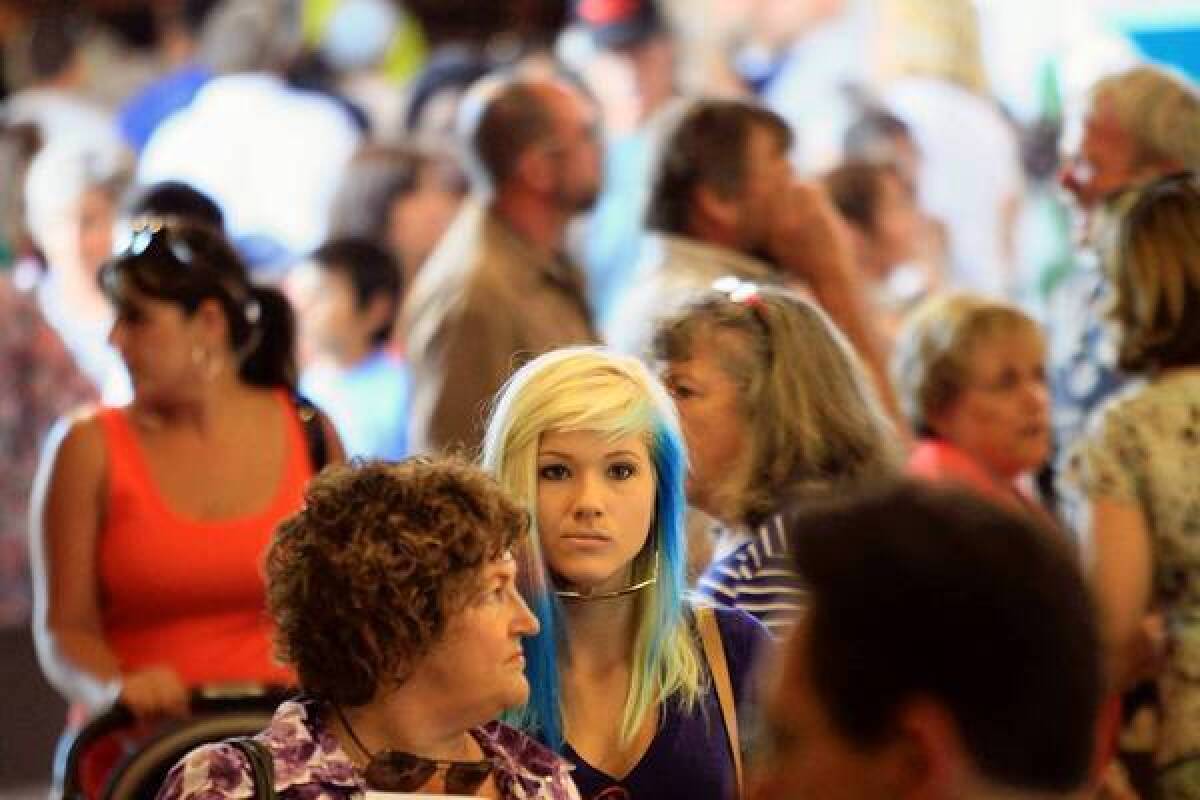San Pedro reinventing itself as coastal destination

For years, officials in San Pedro have tried to spruce up the Port of Los Angeles by adding parks, trails and fountains along the water’s edge. But it was never enough to entice Angelenos to make the trek down to the southern tip of the county.
This summer, the community is hoping its fortunes are about to change.
The arrival of the Iowa, a World War II battleship turned floating museum, is expected to draw 400,000 visitors a year after it opens Saturday. Another lure: the opening of a massive marketplace of handmade goods and specialty food.
It’s all part of a $1.2-billion master plan to turn the port into a coastal destination.
Photos: Revival of the San Pedro waterfront
“We’ve been developing this piece by piece for years,” said Phillip Sanfield, the port’s spokesman. “Now it’s all finally coming together.”
But some business owners worry that San Pedro might lose its charm as an eclectic city by the sea. And residents fear the redevelopment of the Ports O’ Call Village will drive out the working-class Mexican immigrants who frequent it.
“The benefit of being neglected for so long is that we have these unique family-owned businesses,” said Andrew Silber, owner of the Whale & Ale, a local restaurant. “We don’t want to become another one stop, stucco community.”
The Iowa was never part of the initial redesign approved by the Los Angeles Harbor Commission in 2009. But officials have used the buzz to draw experienced developers to elevate the plan to a grander scale.
The latest project is Crafted at the Port of Los Angeles, an arts mecca envisioned by Wayne Blank, who transformed an old Southern Pacific rail yard into the successful Bergamot Station Arts Center in Santa Monica. This time, Blank’s team is turning two rundown World War II-era warehouses into an indoor crafts market where independent artists can sell their works.
Crafted open its doors Friday, with 100 market stalls filled with jewelry, ceramics, knits, leather goods and snacks. Shoppers, eager for the first glimpse at the space and merchandise, lined up outside the doors while the ribbon-cutting ceremony was underway.
“We all have high hopes,” said Shelly Chin, 58, a third-generation San Pedro resident. “Everybody said this is what we need to get a good reputation from around the city and attract visitors.”
The project is expected to take two years to complete, and will eventually have 500 market stalls. It will be open every Friday, Saturday and Sunday.
To show their commitment, the developers signed a 35-year lease with the Port of Los Angeles.
“We’re in it for the long run,” said Alison Zeno, a general partner of Crafted.
Officials hope the recent flurry of activity will prompt developers to compete for the chance to make over the charming but ailing Ports O’ Call Village, a New England-style fish market that attracted 1 million visitors a year in its heyday in the 1980s.
Requests for proposals will be sent out next month and officials want to pick a plan and developer by the end of the year.
Just a few years ago, tall cranes filled the skyline and merchant ships hogged the coast. A hundred chemical containers sat empty along the harbor for decades, taking up prime real estate. The view of the Pacific Ocean was largely obstructed.
Although visitors would stop by to watch the maritime theater of the nation’s busiest port, the destination couldn’t compete with places like Santa Monica’s Third Street Promenade and Old Pasadena.
Developers, who saw the area’s potential, started building high-rise luxury condominiums in the early 2000, but it took more than a decade for officials and residents to hammer out a vision for the new LA Waterfront.
The first task involved freeing up the water’s edge. The big ship lines and cranes were pushed to Terminal Island. The unsightly containers were demolished.
Now, officials expect to spend the next two decades giving the area a face-lift, one project at a time.
“We’re not wiping out everything all at once and bringing in this upscale air,” said Cindy Miscikowski, president of the Los Angeles Board of Harbor Commissioners.
The installation of the parks, a promenade and water fountain was only the start. Over the next two years, officials hope to open a marine research center and a downtown square near the water.
At its completion, the LA Waterfront is expected to bring in 5,000 permanent jobs.
City Councilman Joe Buscaino, whose 15th District encompasses San Pedro and Wilmington, said that the redevelopment is just what his struggling district needs to create economic stability and reduce crime.
Buscaino, a former police officer, recalled arresting drug addicts, prostitutes and gang members off Francisco Street, where L.A. Live now stands.
“I see what economic development can do to a community,” he said. “What L.A. Live has done is weeded out poverty, weeded out the criminal element and put people back to work.”
John Papadakis, a longtime San Pedro resident and early champion of the waterfront redevelopment, sees the port as an untapped asset that can bring big money into the city.
“Here, we have an urban seaside mecca in the heart of the Pacific Rim within miles of millions,” he said.
And the plan seems to be working.
Hundreds of shoppers flocked to Crafted’s opening Friday. They perused handmade leather bags, beaded earrings and artisanal jams, marinades and salts.
The numerous shoppers caused a minor traffic jam when they only made it a few feet inside before stopping to examine a display of hanging glass orbs filled with live plants.
Photos: Revival of the San Pedro waterfront
San Pedro resident Richard Leach paid $10 for one of the plants, then turned to his wife and said: “We should’ve brought more cash.”
More to Read
Sign up for Essential California
The most important California stories and recommendations in your inbox every morning.
You may occasionally receive promotional content from the Los Angeles Times.











